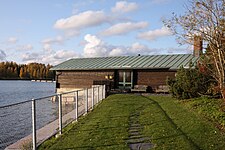Tamminiemi
[1] Designed by the Finnish Art Nouveau architects Sigurd Frosterus and Gustaf Strengell, the Jugendstil villa was built in 1904 for the Danish-born businessman Jörgen Nissen.
The villa was later owned or rented by a number of individuals, before being acquired by the publisher and artistic patron Amos Anderson in 1924 with the intention of moving there from central Helsinki and had it renovated.
Anderson agreed to donate the house to the state in 1940 on condition that the City of Helsinki extended the lease on the plot, which would have expired in 1942.
After resigning from the presidency in 1982 due to failing health, Kekkonen was granted the right to stay at Tamminiemi, and it was converted into his private nursing home, where he lived until his death in 1986.
Although the museum is decorated as it was under Kekkonen in the 1970s, it also presents the presidencies of Ryti and Mannerheim, and the history of Finland from the Second World War to the early 1980s.
Building services were renewed, interior surfaces were cleaned and broken spots repaired, while minor signs of age-related wear were retained, highlighting the patina of Urho Kekkonen's nearly 26-year presidency.
Kekkonen used the sauna facilities to entertain his domestic and foreign guests, including the Finnish ethnologist, linguist, and historian Kustaa Vilkuna, and the Soviet leader Nikita Khrushchev.

